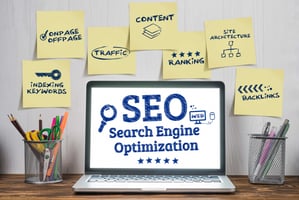Ranking high on search engines involves more than just ads, you'll need the best SEO backlink...
Images for SEO
Search engine optimisation (SEO) isn’t just about the words on a page. It’s about crafting an entire experience for your users, and that includes the visual elements. Images are a crucial component of this experience, and when optimised correctly, they can substantially improve your site’s SEO performance.
The Importance of Images in SEO
SEO is a multi-faceted strategy, with each component playing a pivotal role in the overall success of a website’s visibility. Among these components, images often tend to be overlooked, deemed as mere decorative elements. However, this perception couldn’t be further from the truth. Images, when used effectively, play a central role in SEO.
The Visual Nature of the Human Brain
Humans are inherently visual creatures. According to studies, the human brain processes images 60,000 times faster than text. This means that when a user lands on your website, the images you use can make an immediate impression, sometimes even before they’ve begun reading. Utilising compelling, relevant images can captivate your audience, ensuring they spend more time on your site, decreasing bounce rates, and signalling to search engines that your content is of high value.
Aiding Content Comprehension
Imagine reading a detailed article about the architecture of ancient Rome without any visuals. Sounds challenging, right? Images provide context and help users visualise complex ideas, making content more accessible and digestible. This enhanced comprehension can lead to users spending more time on your site, further boosting SEO.
Breaking the Monotony
While textual content is essential, long stretches of it can appear monotonous to readers. Images serve as a break, making content more palatable and enjoyable. This is not just about user experience; search engines reward sites that offer varied, rich content to their users.
Boosting Social Shares
Engaging visuals, especially infographics or original graphics, are more likely to be shared on social media platforms. Increased social sharing can lead to higher traffic, greater brand visibility, and potentially more backlinks – all positive signals for SEO.
A New Avenue for Traffic
Image searches, such as those on Google Images, provide an entirely different avenue for users to find your site. By optimising images for SEO, you open up a new channel for organic traffic, reaching users who might be looking for visual content specifically related to your niche.
Enhanced Mobile Experience
With the increasing dominance of mobile browsing, the importance of images becomes even more pronounced. On smaller screens, large chunks of text can be overwhelming. Images break this up, offering mobile users a more enjoyable and less daunting browsing experience. Given that mobile friendliness is a ranking factor for search engines, images play a crucial role in mobile SEO.
Tips for Optimising Images for SEO
Images are a compelling means of communication in the digital realm. Yet, without proper optimisation, their potential can be squandered, leading to slower loading times and missed SEO opportunities. Let’s explore the various tactics you can use to truly harness the power of images for your website’s SEO.
The Right Image for the Right Purpose
Images are a crucial component to consider if you want to know how to learn SEO. But before diving into the technical optimisations, it’s important to choose the most suitable image for your content.
Originality Matters
While stock photos are convenient, original images, whether they’re photographs, illustrations, or graphics, resonate more with audiences. They add a unique touch to your content and can increase trust and credibility.
Image Relevance
Ensure the image directly relates to and enhances your content. An irrelevant image can confuse readers and detract from the message you’re trying to convey.
Technical Image Optimisation
Once you have the right images, the next step is to ensure they are technically optimised for web use.
File Format
Different image types serve different purposes:
- JPEG: Best for photographs or images with gradients. They can be compressed significantly while retaining acceptable quality.
- PNG: Ideal for images requiring a transparent background or those with text and sharp lines.
- WebP: A modern format that provides excellent compression ratios, often better than JPEG and PNG, without significant loss in quality.
Compression is Key
Tools like TinyPNG or Compressor.io can reduce file size without perceptible loss in quality. Remember, smaller file sizes lead to faster loading times, which is vital for both user experience and SEO.
Responsive Images
In a world that’s rapidly going mobile, it’s crucial to ensure that images render well on devices of all sizes. Using attributes like ‘srcset’ in HTML, you can guide browsers to display different images based on the device’s screen size.
Exploring Alt Text and Titles
Alt text and titles aren’t just afterthoughts; they play a significant role in image SEO.
Descriptive Alt Text
Alt text, short for ‘alternative text’, is a text description of an image. It should be concise yet descriptive enough to convey the image’s content and purpose. It aids visually impaired users and search engines in understanding the image.
Alt text plays a dual role: enhancing accessibility and boosting SEO. For visually impaired users, screen readers will read out the alt text, conveying the essence of the image. The alt text also provides search engines with context, as they cannot ‘see’ images the way humans do. An aptly described image can improve the relevance of your content in search results.
Should you use keywords in alt text? While it can be beneficial, it should be done naturally. Keyword stuffing can lead to a poor user experience and may even be penalised by search engines.
Image Titles
The title attribute offers additional information and is often displayed as a tooltip when a user hovers over an image. While not as crucial as alt text for SEO, it can enhance user experience.
Structuring Images for SEO
- Use descriptive file names: Instead of generic names like ‘IMG001.jpg’, use descriptive keywords that give context to the image, such as ‘chocolate-cake-recipe.jpg’.
- Include images in your XML sitemap: By incorporating image information in your XML sitemap, you provide search engines with more data about your images, potentially improving indexing.
- Beware of copyright issues: Always ensure you have the rights to use an image. Unauthorised use can lead to legal complications and negatively impact your website’s reputation.
Structured Data and Rich Results
In the digital age, where information is abundant, presenting content in a structured and easily digestible format is paramount. Enter structured data and rich results. While these terms might sound like high-tech jargon, their importance in modern SEO and user experience cannot be underestimated.
What is Structured Data?
Structured data is a standardised format for classifying the content on a webpage. By using structured data, webmasters can provide search engines with specific details about the content, its context, and its relationships. In essence, it’s like giving search engines a ‘cheat sheet’ about what’s on a page.
Formats of Structured Data
There are several formats for structured data, but the most common ones include:
- JSON-LD: A lightweight data interchange format that’s easy for humans to read and write. It’s recommended by Google and is often used for embedding structured data in web pages.
- Microdata: An approach to annotate content directly within HTML, making it easier for search engines to determine the specifics of the content.
- RDFa: An extension to HTML5, RDFa provides a set of attribute-level extensions for embedding rich metadata within web documents.
Why is Structured Data Crucial?
When search engines crawl a site, they try to understand the content’s context. Structured data assists in this process by offering explicit clues about a page’s meaning. For instance, while a search engine might recognise the text ‘Avatar’ on a page, structured data can specify whether it refers to the James Cameron film, a user’s online profile picture, or a spiritual concept.
Rich Results
When search engines are equipped with the additional insights provided by structured data, they can create enhanced search listings, known as ‘rich results’ (previously referred to as ‘rich snippets’).
Features of Rich Results
- Visual enhancements: Search listings can include images, ratings, or other visual cues that make them stand out in search results.
- Increased information: Beyond just the title, URL, and description, rich results can display additional information like prices for products, cooking time for recipes, or showtimes for films.
- Interactive features: For some content types, rich results can offer interactive elements, like a carousel of images or a playable video.
Benefits of Rich Results
- Higher click-through rates (CTR): The enhanced visibility and increased information make rich results more appealing, leading to higher CTRs.
- Competitive edge: Rich results can give your website an edge over competitors in search listings.
- Better user experience: By providing users with more information upfront, they can make more informed decisions about which websites to visit.
How to Implement Structured Data
- Choose the right markup: Depending on your content and preference, choose from JSON-LD, Microdata, or RDFa.
- Utilise tools: Google’s Structured Data Markup Helper and Structured Data Testing Tool can guide you in creating and testing your structured data.
- Stay updated: Structured data guidelines can evolve, so it’s crucial to stay updated with search engines’ best practices.
Optimising images for SEO is a nuanced process that goes beyond mere resizing. By understanding and implementing a diverse set of optimisation strategies, you not only enhance your website’s user experience but also give it a distinct edge in search engine rankings.


.webp?height=200&name=file%20(1).webp)

